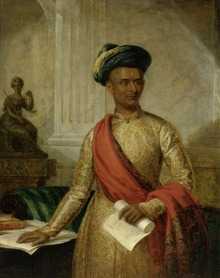Purnaiah
| Purniya, Prime Minister of Mysore | |
|---|---|
 | |
| 1st Diwan of Mysore | |
| In office 30 June 1799 – 23 December 1811 | |
| Succeeded by | Bargir Bakshi Balaji Rao |
| Personal details | |
| Born | 1746 CE Coimbatore |
| Died | 27 March 1812 Srirangapatnam |
| Religion | Hinduism Brahmin |
Purnaiah (Purniya)(1746 - 27 March 1812), aka Krishnacharya Purniya or Mir Miran Purniya was the Dewan of Mysore. He served under Hyder Ali, Tipu Sultan, the British and Mummadi Krishnaraja Wodeyar. He was well known for his skill with accounts, prodigious memory, proficiency in several languages and sheer hard work.
After Tipu Sultan's defeat, Mummadi Krishnaraja Wodeyar, was duly educated and trained by Purniah.
Early years and rise
Purniah came from a humble Madhwa Brahmin family, and was born in 1746 CE. He lost his father at the age of eleven, and had to seek employment to support his family. He started writing accounts at a trader's shop. This grocer had close contact with a rich merchant Annadana Setty who supplied large quantities of groceries to Hyder Ali's palace and army.
Through this connection Purniah very soon earned confidence of Hyder Ali because of his proficiency in accounting and excellent handwriting. Endowed with prodigious memory, proficiency in several languages and sheer hard work, Purniah became head of Accounts Department and a confidant of the ruler.
Purniah knew Kannada, Sanskrit and Persian. He understood English, but could not read or write the language.
Years with Tipu
In 1782, when Hyder Ali died, near Chittoor, Tipu was encamping in Malabar coast. Purniah kept the king's death a top secret, and sent the word to Tipu by the speediest way possible. Meanwhile Hyder's body was kept embalmed, and business went on usual. Purniah thus played a key role in keeping the news of Hyder's death confidential, as many adversaries could have seized this advantage and tried to usurp throne. Purniah thus paved the way for the succession of Tipu.
Purniah became a member of Tipu's inner cabinet. He was the only Hindu in an all-Muslim team.
Purniah attended every military campaign Tipu Sultan led. In the Third Anglo-Mysore War of 1792, Purniah commanded a rocket units (131 men).[1] In his last battle with the British, Tipu had entrusted his eldest son and heir-apparent to Purniah's care. Tipu died on the battle field in 1799.
Meeting with British

After Tipu's death Purniah sought an interview with the General Harris, who was very much impressed with Purniah's political acumen, maturity and fearlessness. He informed the General that administration had nearly collapsed, many of the able army and civil officers were killed and plundering had already set in.
The British were more than convinced. They made Purniah the first Dewan of the newly formed state of Mysore. Queen Regent Lakshammanni readily agreed to the arrangement. The Child-King, later Mummadi Krishnaraja Wodeyar, was duly educated and trained by Purniah. He was granted the jagir of Yelandur by the Maharaja of Mysore at a special Durbar on 27 December 1807.
Krishnaraja Wodeyar attained the age of 16 in early 1810 and hence attained the age of discretion. After discussing with the British Resident, A. H. Cole, the reins of the state were transferred from Dewan Purnaiah to the king. Purniah retired from service in 1811 (and died shortly thereafter).
The photo of the bungalow at Bangalore shown as that of Purniah is actually that of his grandson Sir Narasinga Rao Purniah Krishna Murthy, who was also Dewan of Mysore during the first decade of the 1900s. Purniah's bungalow is at Yelandoor, which is now a taluq headquarters at Chamaraja Nagar district. This Yelandoor bungalow is now developed as a museum for Dewan Purnbiah's memory by Karnataka Government.
Years with Wodeyars
| “ | "The Diwan seems to pursue the wisest and the most benevolent course for the promotion of industry and opulence" (Gen. Wellesley in Kamath 2001, p. 249) | ” |
Purniah's first concern was law and order. He suppressed the revolting Palegars (local chieftains) who had become despots. He started releasing cash allowances to Mathas, temples and dargahs, which Britishers had stopped after Tippu Sultan's death. He opened a judicial department for peoples' complaints.
His public works have left a great legacy. About nine mile canal was dug to supply drinking water to Mysore. Several tanks were dug. A stone bridge, dedicated to Marquess of Wellesley, the Governor General was constructed across river Kaveri connecting Srirangapattana with Kirangur.[2] It has stood stead fast for the last two hundred years.
Large number of choultries were built in the name of Maharaja of Mysore, but people called them "Dewan Purniah's Chatras". They were available to all travelers.
Revenue administration was streamlined. Mysore state had a volatile border with incessant skirmishes, a legacy of the previous regime. Methodical land surveys were conducted. Borders were notified. Posts of Shekdars, Amaldars and Tehsildars were created which came down to modern times.
He was duly honored with big grants and a large pension. His desire to make his position a hereditary one, just like that of a ruler, did not materialize.
Purniah is remembered for laying the foundation of sound administrative machinery for the state. Mysore came to be recognized as one of the foremost progressive native states in British India.
References
|